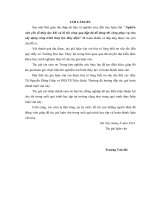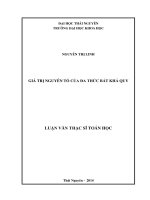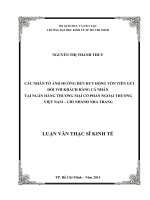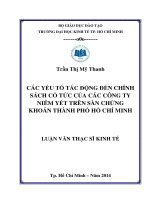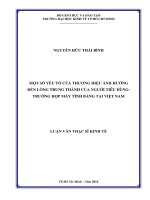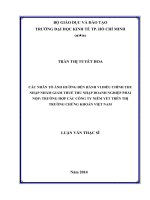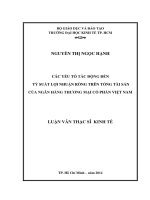(Luận văn thạc sĩ) using language games to improve students retention of ESP vocabulary at namdinh college of construction
Bạn đang xem bản rút gọn của tài liệu. Xem và tải ngay bản đầy đủ của tài liệu tại đây (1.61 MB, 63 trang )
VIETNAM NATIONAL UNIVERSITY, HANOI
UNIVERSITY OF LANGUAGES AND INTERNATIONAL STUDIES
FACULTY OF POST – GRADUATE STUDIES
-------------------
ĐỖ THỊ THU HÀ
USING LANGUAGE GAMES TO IMPROVE STUDENTS’
RETENTION OF ESP VOCABULARY AT NAMDINH
COLLEGE OF CONSTRUCTION
(SỬ DỤNG TRÒ CHƠI ĐỂ NÂNG CAO KHẢ NĂNG LƯU NHỚ TỪ VỰNG CHUYÊN
NGÀNH CHO SINH VIÊN TRƯỜNG CAO ĐẲNG XÂY DỰNG NAM ĐỊNH)
M.A. MINOR PROGRAMME THESIS
Field:
English Teaching Methodology
Code:
601410
Hanoi, 2010
VIETNAM NATIONAL UNIVERSITY, HANOI
UNIVERSITY OF LANGUAGES AND INTERNATIONAL STUDIES
FACULTY OF POST – GRADUATE STUDIES
-------------------
ĐỖ THỊ THU HÀ
USING LANGUAGE GAMES TO IMPROVE STUDENTS’
RETENTION OF ESP VOCABULARY AT NAMDINH
COLLEGE OF CONSTRUCTION
(SỬ DỤNG TRÒ CHƠI ĐỂ NÂNG CAO KHẢ NĂNG LƯU NHỚ TỪ VỰNG CHUYÊN
NGÀNH CHO SINH VIÊN TRƯỜNG CAO ĐẲNG XÂY DỰNG NAM ĐỊNH)
M.A. MINOR PROGRAMME THESIS
Field:
English Teaching Methodology
Code:
601410
Supervisor: Dr. Lâm Quang Đông
Hanoi, 2010
iv
TABLE OF CONTENTS
CANDIDATE’S STATEMENT ................................................................................ i
ACKNOWLEDGEMENT......................................................................................... ii
ABSTRACT ............................................................................................................... iii
TABLE OF CONTENTS .......................................................................................... iv
LIST OF TABLES .................................................................................................... vii
PART 1: INTRODUCTION .................................................................................... 1
1. Rationale of the study ...................................................................................... 1
2. Aims of the study ............................................................................................ 2
3. Scope of the study ........................................................................................... 2
4. Method of the study ......................................................................................... 2
5. Thesis Structure ............................................................................................... 2
PART 2: DEVELOPMENT ...................................................................................... 4
CHAPTER 1: LITERATURE REVIEW ................................................................. 4
1.1. Vocabulary in ESP .......................................................................................... 4
1.1.1. The importance of vocabulary in ESP..................................................... 4
1.1.2. What it means to know words? ............................................................... 4
1.2. Taxonomy of ESP vocabulary ......................................................................... 6
1.3. Factors affecting the retention of ESP vocabulary ........................................... 8
1.3.1. Memory and storage systems.................................................................. 8
1.3.2. Vocabulary learning strategies................................................................ 9
1.3.3. Learning context .................................................................................... 10
1.3.3.1. Language input ........................................................................... 10
1.3.3.2. Language output ......................................................................... 11
1.4. Language games and vocabulary acquisition and retention .............................. 12
1.5. ESP vocabulary teaching – research and practice ............................................ 16
v
CHAPTER 2: AN OVERVIEW OF ESP VOCABULARY TEACHING AND
LEARNING CONTEXT AT NCC ........................................................................... 19
2.1. The learners and their background .................................................................. 19
2.2. The teachers and their teaching method ........................................................... 19
2.3. The textbook ................................................................................................... 20
2.4. The teaching and learning conditions .............................................................. 20
CHAPTER 3: THE STUDY ...................................................................................... 21
3.1. The research hypothesis .................................................................................. 21
3.2. Rationale for using a Quasi-experimental method ........................................... 21
3.3. Variables ........................................................................................................ 22
3.4. Participants and treatment ............................................................................... 22
3.4.1. Participants ............................................................................................ 22
3.4.2. Treatment ............................................................................................... 22
3.5. Procedure of data collection ........................................................................... 22
3.5.1. Test designing ........................................................................................ 22
3.5.2. Test administering .................................................................................. 23
3.6. Results and discussion .................................................................................... 24
3.6.1. Results of the pre-test scores of the two groups and discussion ............... 24
3.6.2. Results of the progress-test of the two groups and discussion ................. 27
3.6.3. Comparison of mean scores and t-scores of the pre-test and progresstest of the two groups ....................................................................................... 30
3.6.4. Results of the post-test of the two groups and discussion ........................ 31
3.6.5. Comparison of mean scores and t-scores of the progress-test and posttest of the two groups ....................................................................................... 34
vi
PART 3: CONCLUSION ......................................................................................... 36
1. Summary of major findings.............................................................................. 36
2. Classroom implications ................................................................................... 36
3. Limitations and suggestions for further study ................................................... 37
REFERENCES .......................................................................................................... 39
APPENDIX 1 (tests and keys) ................................................................................... I
APPENDIX 2 (tables for analysis) ............................................................................ X
vii
LIST OF TABLES
Table 1: Results of the pre-test of the two groups
p.24
Table 2: Comparison of mean scores in the pre-test of the two groups
p.25
Table 3: Pre-test score frequencies of the two groups
p.26
Table 4: Detailed pre-test scores of the experimental group
p.X
Table 5: Detailed pre-test scores of the control group
p.XI
Table 6: Results of the progress-test of the two groups
p.27
Table 7: Comparison of mean scores in the progress-test of the two groups
p.28
Table 8: Progress-test score frequencies of the two groups
p.29
Table 9: Detailed progress-test scores of the experimental group
p.XII
Table 10: Detailed progress-test scores of the control group
p.XIII
Table 11: Comparison of mean scores and t-scores of the pre-test and progresstest of the 2 groups
p.30
Table 12: Independent t-test for the gain in the progress-test of the two groups
p.30
Table 13: Results of the post-test of the two groups
p.31
Table 14: Comparison of mean scores in the post-test of the two groups
p.32
Table 15: Post-test score frequencies of the two groups
p.33
Table 16: Detailed post-test scores of the experimental group
p.XIV
Table 17: Detailed post-test scores of the control group
p.XV
Table 18: Comparison of mean scores and t-scores of the progress-test and posttest of the two groups
p.34
Table 19: Independent t-test for the gain in the post-test of the two groups
p.34
1
PART 1: INTRODUCTION
1. Rationale of the study
Recently, the teaching methodology in General English as well as English for Specific
Purposes (ESP) has shifted from a focus on the linguistic competence to an interest in
the communicative competence. This trend in language teaching has resulted in the
increasingly essential role of teaching and learning vocabulary.
It is of common knowledge that vocabulary is the major part in foreign language
learning. Emphasizing the importance of vocabulary, Wilkins (1972, p.11) states that
“without grammar, very little can be conveyed, without vocabulary, nothing can be
conveyed”. McCarthy (1990, p.viii) also shares the same view when saying “No
matter how well the student learns grammar, no matter how successfully sounds of L2
are mastered, without words to express the wide range of meaning, communication in
an L2 just cannot happen in any meaningful way”.
According to Hutchison and Walters (1987), ESP is one branch of English Language
Teaching, which is a variety of numerous kinds of language teaching. Consequently,
vocabulary acquisition has always been one of the fundamental activities in foreign
language learning whether it is for general purposes or for specific ones because no
communication is possible without words.
Being an English teacher at Namdinh College of Construction, I do realize that
although ESP vocabulary teaching and learning has received much attention so far, it is
still far from satisfactory. Many students encounter difficulty in retaining ESP words
that they have learnt in previous lessons. They often complain that they forget new
words soon after learning them. They also do not know how to learn, remember and
use these words. As a result, for most students, vocabulary learning in ESP lessons is
boring and ineffective. For the above reasons, I would like to conduct this research
entitled “Using Language Games to Improve Students’ Retention of ESP Vocabulary
at Namdinh College of Construction”.
2
2. Aims of the study
The main aim of the study is to investigate the effect of language games on ESP
vocabulary retention, or in other words, the extent to which language games help to
retain ESP vocabulary for my students at the College and suggest some teaching
implications.
3. Scope of the study
There are various language activities that help students to retain ESP vocabulary.
However, within the limit of a minor thesis, this study focuses on the impact of
language games on students‟ retention of ESP vocabulary.
This study was implemented among 2 groups including 100 non-English major first
year students at Namdinh College of Construction whose English was at the elementary
level and who are working with the course book “Nucleus English for Science and
Technology: Architecture and Building Construction” by James Cumming (1996).
4. Method of the study
This research was conducted with quasi-experimental method with one class as the
experimental group and one class as the control group. It was quasi-experimental
because the students of both groups were not randomly assigned, and therefore were
not of equal proficiency levels of English. The experiment lasted 10 weeks and 3
vocabulary tests were administered to measure students‟ retention of ESP vocabulary.
Students‟ memorization of vocabulary is also continuously monitored when the games
are being in progress so as to provide further evidence of the games‟ effectiveness.
The results of the tests were analyzed by using Paired Samples T-test to find out the
gain of each group and Independent t-test to compare the gains of two groups.
5. Thesis Structure
This thesis consists of three parts, namely Introduction, Development and Conclusion.
Part 1, the Introduction, presents the rationale, the aims, the scope and the method of
the study.
Part 2 is the development which includes three chapters. Chapter 1 provides theoretical
background to teaching and learning vocabulary, particularly in ESP. Also, it reviews
3
some language games which help the retention of ESP vocabulary. Chapter 2 gives an
overview of ESP vocabulary teaching and learning context at Namdinh College of
Construction. Chapter 3 presents detailed analyses of the data obtained through the
pretest, progress-test and posttest.
Part 3, the Conclusion, discusses the major findings and limitations of the research as
well as provides suggestions for further study.
4
PART 2: DEVELOPMENT
CHAPTER 1: LITERATURE REVIEW
1. 1. Vocabulary in ESP
1.1.1. The importance of vocabulary in ESP
Recently, vocabulary has rapidly changed in status from a “neglected aspect of language
learning” (Meara, 1980) to an area of growing research and publication. The significance
of vocabulary in language learning has drawn numerous researchers‟ interest. Zimmerman
(1997, p.5) states that “Vocabulary is central to language and of crucial importance to the
typical language learner.” Robinson (1991) shares the same view by saying “for many
people vocabulary, particularly specialist vocabulary (or terminology), is a key element of
ESP” (as cited in Jahangard, 2007, p.8). Obviously, vocabulary is of great importance in
foreign language learning whether it is for general purposes or for specific ones. To
emphasize this, Keith S. Folse (2004, p.1) claims that vocabulary is the most significant
aspect among numerous language learning ones such as pronunciation, writing system,
syntax, pragmatics, rhetorical modes for reading and composition, culture, and spelling.
Carter and McCarthy (1988) also point out that the study of vocabulary is at the heart of
language teaching and learning. Hence, it cannot be denied that vocabulary acquisition is a
“must” for language learners especially ESP learners.
1.1.2. What it means to know words?
Knowledge of a word is not only limited to knowing its single meaning but this involves
comprehension of the word form, meaning, grammar and collocation…..so that language
learners can generate it for their need. According to Penny Ur (1996), when the teacher
teaches a new English word, he should, by all means, provide his learners with its
pronunciation and spelling, word form, grammar, collocation, aspects of meaning, and
word-formation.
•
Word form
Each English word has its spelling and pronunciation. Therefore, when introducing new
words to learners, the teacher should pay careful attention to both of these forms and
provide learners with certain general guidelines which assist them in predicting the
5
pronunciation of new lexis. However, there are so many exceptions in English
pronunciation. The complicated relationship between sound and spelling in English makes
it difficult for foreign language learners to deal with the pronunciation of new words.
Hence, together with introducing general guidelines, the teacher should also offer learners
fairly specific rules for English pronunciation.
•
Grammar
It is important to offer information about the grammar of a word to learners. They need to
know the grammatical function, the unpredictable change of form in certain grammatical
contexts, the regularity and irregularity, the singular and plural forms of the new word so
that they can use it correctly. For example, when teaching a verb, the teacher should also
give its past and past participial form if it is irregular. Similarly, when teaching a noun, the
teacher should provide students with information about whether a word is countable or
uncountable, its plural form, if it is irregular, information regarding different forms of a
word, the preposition that collocates with the words, etc.
•
Collocation
Collocation is the way in which words are used together regularly in a specific language. It
refers to the restriction on how words can be used together in right contexts. Lewis (2000)
asserts that 70% of English language is made up of chunks of lexicon that co-occur
together in order to produce natural sounding language. Thus, this is another piece of
information about a new item, which may be worth teaching. When introducing words
such as “to make” and “to do”, for example, the teacher may note that both words mean “to
perform” but can be differentiated by the words they collocate with. We often say “to make
a mistake” but never say, “to do a mistake”.
•
Meaning
Aspect of meaning consists of denotation, connotation, appropriateness and meaning
relationship.
The meaning of a word is primarily what it refers to in the real word, its denotation. This
meaning is found in dictionaries. For example, house denotes a building for people to live
in, usually for one family.
6
Connotation of a word is less obvious component of its meaning. This is the association or
positive or negative feelings the word evokes which may be not presented in dictionaries.
The connotative meaning of a word is varied from context to another.
Appropriateness is more subtle aspect of meaning that indicates whether a particular item
is appropriate one to use in a certain context or not. Thus, it is useful for a learner to know
that a certain word is very common or relatively rare in conversation or tends to be used in
writing but not in speech.
Meaning relationships can also be useful in vocabulary teaching and learning. They show
how the meaning of one item relates to the meaning of others. There are various
relationships such as synonyms, antonyms, hyponyms, co-hyponyms, superordinates and
translation.
Word-formation
Vocabulary items, whether one-word or multi-word, can be broken down into their smaller
components. How these components are put together is useful information to learners.
According to Gairns and Redman (1986), there are three main forms of word building,
which are characteristics of English. They are affixation (the process of adding prefixes
and suffixes to the base item); compounding (the formation of words from two or more
separate words) and conversion (the process by which an item may be used in different
parts of speech).
1.2. Taxonomy of ESP vocabulary
Vocabulary in ESP texts can be analyzed according to different points of view. According
to Hutchison & Walter (1987, p.165), there are four types of vocabulary as follows:
structural (are, this, only, however, etc), general (table, run, dog, road, etc), sub-technical
(engine, spring, value, acid, budge, etc) and technical (auricle, schistosome, fissure,
electrophoresis, etc). Born-Lechleitner (1992, p.67) shares the same distinction. He
explains that the meaning of highly technical words tend to be exact, specific, systematic,
concrete, emotionally neutral, self-explanatory, economical and transparent. Sub-technical
words are popularly used in general English with a specialized meaning within science or
technology. Certain general language vocabulary such as note, observe, item, device, etc.,
with a low priority in general language still retains its meaning in all scientific and
7
technical disciplines. The fourth group of words, which plays a prominent role in ESP
texts, is that of structural/procedural/functional words. Words like articles, conjunctions,
prepositions, and auxiliary verbs amount to 50% of all words in a technical text, a
frequency which is only exceeded in spoken language.
Robinson (1991, as cited in Viel, 2002) classifies vocabulary of ESP into three groups in
terms of their semantic ambiguity: ultra specialized vocabulary, general scientific and
technological words and words are on the fringe of general English. Ultra specialized
vocabulary, with a unique and precise meaning in the science or technology, is never used
in communication except within the field of specialists. General scientific and
technological words mention situations, actions, problems, etc. which are popular in most
fields from research to technology. Words on the fringe of general English are utilized for
general purposes in any kind of communication whose frequency of use is greater in
English for science and technology.
In discussing the teaching of ESP, it has often been said that the teaching of technical
vocabulary is not the responsibility of the ESP teacher and that priority should be given to
the teaching of “semi-technical” or “sub-technical” words (Tony Dudley-Evans & MaggieJo St. John, 1998, p. 80). Robinson also suggests an important role for semi-technical
vocabulary: “course books…perhaps do not need to concentrate on the very specialized
vocabulary items as students will get these from other sources. Rather it is the subtechnical level which is often difficult”. Inman (1978, p. 246), in a study of over 100,000
words of scientific and technical prose, found that 9% of occurrences are function words,
21% technical vocabulary and 70% sub-technical vocabulary. She concludes that it is “subtechnical vocabulary which should be focused on in teaching scientific and technical
English. Technical vocabulary …is best left to presentation through the discipline itself”.
In general, the largest part of General English vocabulary is hardly or even never used in
specialized fields. About 80% or 90% of GE vocabulary falls outside the range of ESP.
However, a number of words are presented widely in both specialized and general
contexts. The words half way between lexis and grammar such as articles, auxiliary verbs,
preposition, linking words, etc… are the backbone of the language without which no
complex meaningful sentence can ever be built. They naturally do not belong to the
8
language of ESP but are essential. Besides, semi-technical or sub-technical should be given
priority in teaching by ESP teacher because of its above importance.
1.3. Factors affecting the retention of ESP vocabulary
1.3.1. Memory and storage systems
“Understanding how we store information in the memory and why certain chunks
of it seem to „stick‟ while others slip away is obviously a matter of concern to
anyone whose work involves helping others to learn. For language teachers this
knowledge should help to establish classroom procedures that will promote more
effective learning and retention of new language items”
(Gairns & Redman, 1986, p.86)
It is obvious that comprehending how our memory works might assist us to create more
effective ways to teach vocabulary. According to Gairns & Redman (1986, p.87-88), there
are two types of memory: short-term memory and long-term memory. Short-term memory
has the limited capacity, storing things over a brief period of time. Meanwhile, long-term
memory can hold any number of items inexhaustibly. Peet (2003) has a different
classification. He divides memory into three kinds: short-term memory, working memory
and long term memory. Short-term memory is capable of retaining limited information for
a few seconds whereas working memory stores things for up to twenty seconds. Finally,
long-term memory can hold items in our mind to use later. This is an automatic processing
procedure that ensures retrieval without effort.
It seems that there are two phases in learning new items; that is storing them first in our
short-term memory, and afterwards in long-term memory. Although we do not take control
of this process consciously, there seem to be some important clues to consider. First,
retention in short-term memory is not effective if the number of chunks of information
exceeds seven. Therefore, this suggests that in a given class we should not aim at teaching
more than this number. However, our long-term memory can hold any amount of
information. Secondly, word frequency is another factor that affects storage, as the most
frequently used items are easier to retrieve. Thirdly, forgetting seems to be an inevitable
process, unless learners regularly use items they have learnt. Hence, recycling is vital, and
ideally new words should be met again and again in different contexts one or two days
9
after the initial input, in different contexts so that learners can internalize them gradually.
After that, weekly or monthly tests can check on previously taught items.
1.3.2. Vocabulary learning strategies
It has been suggested that teaching vocabulary should focus on not only teaching specific
words but also providing learners with strategies necessary to develop their vocabulary
knowledge.
Vocabulary strategy use has been proved to have effect on vocabulary acquisition as well
as retention. Cohen and Aphek (1981, as cited in Chamot, 2001) state that students who
remember vocabulary by making paired mnemonic associations retain vocabulary more
effectively than those who do not. In another attempt, Sanaoui (1995) concludes that
learners who have structured learning approach are more successful in retaining vocabulary
items than those who have unstructured learning approach. Schmitt (1997) and Nation
(2001) also agree that vocabulary learning strategies facilitate the acquisition of new lexis
in the second/foreign language because they aid in discovering the meaning of a new word
and in consolidating a word once it has been encountered. Therefore, teachers are
recommended to train their students in different vocabulary learning strategies because
there is no utmost best strategy for all learners learning foreign language vocabulary.
Effectiveness of learning is not constrained to just one or two strategies. A good language
learner uses many different vocabulary learning strategies, then employs and individualizes
the ones that are workable and applicable to them when performing specific tasks.
A number of attempts have been made to develop a taxonomy of vocabulary learning
strategies. Gu and Johnson (1996) list VLS as metacognitive, cognitive, memory and
activation strategies whereas Schmitt (1997, p.207-208) distinguishes the vocabulary
learning strategies as two groups: the ones to determine the meaning of new words when
encountered for the first time, and the ones to consolidate meaning when encountered
again. In a recent attempt in ESP context, Zahra Akbari & M.H. Tahririan (2009, p.57-58)
classify the vocabulary learning strategies into two categories: comprehension (strategies
for the discovery of a new word‟s meaning) and learning strategies (strategies for
consolidating a word once it has been encountered). The first contains determination and
10
transactional strategies and the second includes the knowledge-oriented and skill/useoriented strategies.
In short, each scholar has his/her own idea about grouping vocabulary learning strategies
basing on results of their research on a certain type of language learners. However, it is
apparent that when a learner consciously chooses strategies which are suitable for his/her
learning style and the tasks, these strategies become a useful toolkit for active and
purposeful self-regulation of learning.
1.3.3. Learning context
Learning context or the learning environment is the socio-cultural-political environment
where learning takes place. Gu (2003) states that the learning context involves the teachers,
the peers, the classroom climate or ethos, the family support, the social, cultural tradition
of learning, the curriculum and the availability of input and output opportunities.
However, in the range of this study, the author would like to focus on two factors that
directly constrain the ways learners approach learning tasks and acquire vocabulary
knowledge: language input and language output.
1.3.3.1. Language input
According to Krashen (2004, p.2), learners acquire language when they understand what
they are hearing and reading. That is, the input must be comprehensible in order for it to be
useful and meaningful to the learners and help with acquisition (Krashen, 1982). If learners
do not understand a sizable portion of the vocabulary in the language that they are reading
or hearing, then this language is not comprehensible and therefore cannot be useful for
acquisition (Folse, 2005, p.6).
Krashen‟s hypothesis states that it is important for the acquirer to understand language that
is a bit beyond his or her current level of competence. This means that the language that
learners are exposed to should be just far enough beyond their current competence that
they can understand most of it but still is challenged to make progress. He further presents
that a second language is most successfully acquired when the focus of instruction is on
meaning rather than on form and when there is sufficient opportunity to engage in
meaningful use of that language in a relatively anxiety-free environment. This suggests
that the second language classroom should emphasize on something meaningful, such as
11
academic content, and that modification of the target language facilitates language
acquisition and makes academic content accessible to second language learners.
In the condition of limited natural language environment in Vietnam, the major sources of
input for learners are the teacher and the textbooks. These sources of input are not
sufficient to guarantee successful language learning or vocabulary acquisition. Therefore, it
is necessary to provide learners with opportunities and language activities to use the target
language extensively through practice, games, presentations, and eloquence (Speaking)
contest.
1.3.3.2. Language output
It is acknowledgeable that the development of a learner‟s communicative competence does
not only reply on comprehensible input; the learner‟s output has an independent and
indispensable role to play, too. Swain (1985) first proposed a hypothesis relating to the
second language learner's production comparable to Krashen's comprehensible input
hypothesis termed as the Comprehensible Output Hypothesis for second language
acquisition. Her hypothesis suggests that learners acquire language when there is a
communicative breakdown and learners are "pushed to use alternative means to get across
the message precisely, coherently, and appropriately" (as cited in Krashen, 1998, p. 179).
Swain also offered convincing evidence that the role of learner production is independent
in many ways of the role of comprehensible input, and the comprehensible output
hypothesis is also a necessary mechanism which aids second language acquisition in many
ways. Similarly, the results of Izumi & Bigelow‟s research (2000) on the effect of output
on L2 vocabulary indicated that participants in the with output groups outperformed the
non-output and the control groups on post-test measures.
Obviously, foreign language learners do no have such submersion environment like native
speakers so they have to make use of every chance to “touch” the words. According to
Steele (2005), words are learnt by individual but through memorable presentation,
personalization tasks, and importantly, recycling. Therefore, the vocabulary presentation
and practice play an important role in anchoring new words into students‟ memory,
especially when they do not have advantageous language environment outside the
12
classroom. In this case, classroom practice embeds both input and output resources for the
learners.
1.4. Language games and vocabulary acquisition and retention
Many researchers agree that language games do have a role to play in vocabulary
acquisition. With the use of games, the teacher can create various contexts in which
students have to use the language to communicate, exchange information and express their
own ideas. Stressing the role of games in vocabulary teaching and learning, Huang (1996,
p. 1, as cited in Nguyen & Khuat, 2003) claims that “learning through games could
encourage the operation of certain psychological and intellectual factors which could
facilitate communication, heightened self-esteem, motivation and spontaneity, reinforcing
learning, improving intonation and building confidence.”
Language games have many advantages in vocabulary teaching and learning. Firstly,
games can motivate learners by bringing relaxation and fun to classes. They can help lower
students‟ anxiety, make them comfortable and want to learn more. Uberman (1998)
showed that those students who practiced vocabulary activity with games felt more
motivated and interested in what they were doing. Hansen (1994, p.118, as cited in
Uberman, 1998) also presents that games can provide shy students with more chance to
express their opinions and feeling.
Secondly, games can provide language practice. Lee (1995) and Marion McPherson (2006)
agree that games allow the student to practice the language point being taught. Sharing the
same view, Wright, et al. (1996, pp.3-4) adds that “games can give practice in all the skills,
in all the stages of the teaching or learning sequence and for many types of
communication”. Further support comes from Zdybiewska (1994, p.6), who believes
games to be a good way of practicing language, for they provide a model of what learners
will use the language for in real life in the future.
Thirdly, games can improve students‟ retention. According to Wierus and Wierus (1994, p.
218, as cited in Uberman, 1998), games in vocabulary help students memorize things faster
and better in a comfortable environment. Nguyen and Khuat (2003) also agree that games
can assist students to learn more quickly and retain the learned materials better.
13
Fourthly, games encourage learners to interact and communicate. Zimmerman (1997)
emphasizes that communicative and interact activities can lead to better word learning. In
fact, when taking part in games, learners have to talk to express or exchange their ideas
with their partners. Moreover, through interaction with others, they can help each other on
the meaning of unfamiliar words, including new vocabulary items (Nation and Newton,
1997, p. 244). This is a good opportunity for learners to have exposures to the new items
during the course of activity that serves to generate better input.
In summary, games are of great use and effectiveness that should be applied in vocabulary
classes. The use of games in vocabulary teaching makes lessons more interesting,
enjoyable as well as effective. However, in order to gain the most from vocabulary games,
it is necessary to choose suitable games. Whenever a game is to be organized, teachers
should take the factors such as students‟ level, the number of students, cultural context,
timing, learning topic and the class setting into consideration (Nguyen and Khuat, 2003).
It has been suggested that there are large varieties of word games which are useful for
vocabulary acquisition. In my own teaching context, where students‟ English proficiency is
rather low as well as the learning topic seems insufficiently interesting, the following
language games are expected to get students involved in vocabulary lessons and help them
recall new words more easily.
a. Memory game
This game can be divided into two rounds. In the first one, the class will work in groups to
match the words with the pictures as quickly as possible. In the second round, each group
will appoint one member to write all the words he/she can remember within one minute.
The group that wins both rounds will be the winner.
b. Hot seat
The class is divided into 2 teams: A & B. Team A sits in a group on one side of the
classroom, team B sits on the other side. Two chairs are brought to the front of the room so
that when seated, a student is facing his or her respective team and their back is to the
board. One member from each team sits in their team‟s chair. The teacher writes a word,
phrase, or sentence on the board. The students in the chairs must not see what is written on
the board. Once the teacher yells “go”, the teams have one minute using only verbal clues,
14
to get their seated teammate to say the item written on the board. The only rule is that they
must not say the item written on the board in full or part. The first student is the hot seat to
utter the word scores a point for their team. When the round is over, two new team players
are rotated into the hot seat and a new item is written up. The first team to score a certain
number of points wins.
c. Pictionary
The class is divided into 2 teams: A & B. Team A sits in a group on one side of the
classroom, team B sits on the other side. One member from each team goes to the board.
The teacher flashes them a word, phrase or expression written on a piece of paper. The
students have one minute to get their respective team to say the item only by drawing
pictorial clues on the board. Written words, verbal clues or gestures are forbidden. The first
team to say the word scores a point.
d. Scrambled letters
The teacher writes up eight words with their letters shuffled on the board. When he/ she
says “go”, students, individually or pair, try to arrange the letters as quickly as possible to
make the words. For each word, the fastest student or pair gets a point and at the end of the
game, the student or pair with the most points will be the winner.
e. Noughts and crosses
1
2
3
4
5
6
7
8
9
In this game, students are divided into two groups. One has the name as X (cross) and the
other was 0 (nought). They are presented with a table with 9 numbered squares. For each
square there is a question and if they can answer the question correctly, they can put their
group‟s name (X or 0) in that square. The first group to have their names in three aligned
squares (either vertically or horizontally or diagonally) will be the winner of the game.
Usually the question is like this: “What is the cross-section of the brick?” The answer is
15
only one word which they studied in the previous lesson. They are expected to find the
words and pronounce it correctly.
f. Odd man out
The class is divided into groups. The teacher writes the lists of words on the board. All but
one item in each list must have something in common. Each group discusses the lists and
decides which word is the odd man out, and why. For each list, the fastest group gets a
point and at the end of the game, the group with the most points will be the winner.
g. Complete the word
The class is separated into two teams. One student from each team comes forward and is
given a piece of chalk. The two students must face the class while the teacher writes an
incomplete word on the board (twice, once for each team), e.g.
h _ _ s_
h _ _ s_
Answer: house
The students can then look at the word. The first one to complete the word correctly scores
one point for his team. At the end of the game, the team with the most points will be the
winner.
h. Lucky numbers
This game is played with the class divided into two groups. The teacher draws on the board
a table like this:
1* 2
3
4
5* 6
7
8
9
10* 11 12 13 14 15*
There is a question in each number. The students take turns to choose a number and answer
the questions. If they can answer the question, they will get 2 points. If they can not answer
the question after two times guessing, they lose their chance and if the other group can
make a correct answer, they will get 3 points. However, number 1, 5, 10 and 15 are lucky
numbers because for each of these numbers, students have a special question and if they
can answer the question, they will get 5 points. At the end of this game, the group with the
higher score is the winner.
16
i. Hangman
The teacher thinks of a word that students will know and draws a number of dashes on the
board corresponding to the number of letter in the word. The students are divided into two
teams and one student from each team suggests a letter in turn. If the letter appears in the
word, the teacher writes it in. If the chosen letter is not in the word, the teacher starts to
construct a gallows for that team. One line is added for each wrong choice. Each team can
also make a guess at the word, but only when it is that team‟s turn. A wrong guess means
one more line on the gallows. A correct guess finishes the game. If a team wins by
completing or guessing a word correctly a member of the team takes over as the
“hangman”.
j. Word chain
The students may work in groups or pairs or individually. The teacher gives a word for a
start, e.g. solid. This word ends in -d, so the first student/ pair/ group must give a word
beginning with that letter, e.g. dome. The next one must give a word beginning with –e.
The game will go on like that within a fixed period of time. Each individual/ pair/ group is
given only 15-20 seconds to think of a word. The last who can give a word will be the
winner.
1.5. ESP vocabulary teaching – research and practice
While numerous studies have been conducted in order to make improvement in the
teaching of GE (General English) vocabulary, comparatively little research work has been
performed in the field of ESP. However, this does not mean that ESP teachers merely
undertake their teaching job, following the old path of methods. In fact, they are
endeavoring to search for better teaching methods, techniques and tools.
Various researchers have conducted studies in the field of ESP vocabulary teaching. For
example, Palmero (2002) has explored the phonemic side of vocabulary teaching in
Language for Specific Purposes courses and come to a conclusion of placing the necessary
on pronunciation and finding the adequate balance between the teaching of academic and
sustained-content vocabulary. Likewise, Galina Kavaliauskienë and Violeta Janulevièienë
(2001) suggest that teachers should use lexical phrases for ESP vocabulary acquisition
because these phrases are context-bound and occur quite frequently, which makes them
17
highly memorable for learners. Moreover, they are of great value to improve students‟
competence in language. Another study dealing with ESP vocabulary was carried out by
Ilse Born –Lechleitner (1992). He presented activities which were intended to help
students come to terms with new words. They ranged from simple word-games to fairly
complicated tasks which provided strategies for successfully guessing the meaning of a
new word by using their knowledge of the subject and the German and English languages.
In recent research, Zahra Akbari and M.H. Tahririan (2009) present taxonomies of
vocabulary learning strategy in an ESP context as well as point out effective ways for
teaching and learning vocabulary. They claim that language teacher need to improve their
awareness of their students‟ strategy usage and needs so as to be able to facilitate their
language learning process. Besides, students should be taught how to develop both breadth
and depth of their vocabulary knowledge so that they would be able to use their vocabulary
knowledge both receptively and productively as the need arises.
A number of studies on ESP vocabulary retention have been conducted. Derin Atay &
Cengiz Ozbulgan (2007) investigated the effects of memory strategy instruction and
learning through context on the ESP recall of Turkish EFL students. The result revealed
that the experimental group with memory strategy instruction had significantly better
vocabulary gain scores than the control students. Jahangard (2007) suggests that there is no
statistically significant difference between the students‟ ability to memorize the technical
and the general vocabulary. In fact, memory efficiency for both types of vocabulary was
found to be equal. It seems that the pace of forgetting for both types of vocabulary is
almost the same.
It can not be denied that such results are of great use in the teaching of ESP vocabulary.
However, it is essential to have more and more research in this field as ESP is a large
concept that covers numerous types of professional terms, words and phrases. For each
type, there is a need for detailed studies in order to make development in vocabulary.
It is factual that little attention is emphasized on using games in context of ESP vocabulary
learning and teaching in Vietnamese condition and no research has investigated strategies
for ESP vocabulary retention among Vietnamese learners. In NCC, the use of games in
teaching and learning ESP vocabulary has never been taken seriously. Consequently, the
author would like to conduct a quasi-experimental research to find out whether the
18
application of games can improve ESP vocabulary retention among the College‟s students
or not, and what can be the most appropriate games for this particular type of ESP students.
19
CHAPTER 2: AN OVERVIEW OF ESP VOCABULARY TEACHING AND
LEARNING CONTEXT AT NCC
2.1. The learners and their background
Most students who enter NCC are male students and aged from 18 to 24. About 90 % of
them failed the national entrance examination to universities. They are mainly from the
countryside, where there are no good opportunities for studying English. Furthermore, they
consider English an extra subject, so they learn English just to pass the exam. Generally,
the target students‟ English proficiency is still low.
The typical learning style of the students at NCC is quite passive and dependent on the
teachers. They learn by heart vocabulary as well as grammatical rules and prefer
everything being translated. They would rather do written work and private reading than
work in pairs or groups. As a result, they pay more attention to forms than functions and
meanings.
Having special knowledge in Vietnamese, students at NCC do not have difficulty in
understanding the construction terms; however, their major problem is the vocabulary
learning. The technical words are not only rarely found in their daily conversation but also
longer and more difficult to pronounce than general words. Consequently, they find it hard
to remember and guess the meaning of new words.
2.2. The teachers and their teaching method
The English Department at NCC consists of six teachers at the age from 25 to 38. They all
graduated from universities of foreign languages and two of them are taking MA courses.
They are enthusiastic and willing to devote their time and energy to teaching. However,
they encounter difficulties in teaching ESP due to the lack of knowledge about the field,
lack of authentic materials and lack of appropriate methodology. Consequently, they do not
feel confident to teach ESP although they have positive attitudes towards it.
In terms of methodology, although the teachers are aware of different kinds of teaching
methods such as the Direct Method, the Audio-Lingual method and the Communicative
approach, they usually employ the traditional teaching method - that is GrammarTranslation. In classes, explanation, translation and sentence making up exercises are the
core activities. The teacher plays the key role in class, explaining new words and


